Do You Have to Have a Family Member Burried in Cemetery to Be a Cemetery Board Member
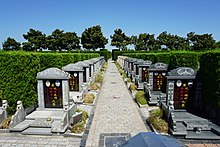
A cemetery, burial ground, gravesite or graveyard is a place where the remains of dead people are buried or otherwise interred. The word cemetery (from Greek κοιμητήριον , "sleeping place")[one] [two] implies that the state is specifically designated every bit a burial ground and originally applied to the Roman catacombs.[three] The term graveyard is ofttimes used interchangeably with cemetery, but a graveyard primarily refers to a burial basis within a churchyard.[4] [v]
The intact or cremated remains of people may be interred in a grave, usually referred to equally burial, or in a tomb, an "above-ground grave" (resembling a sarcophagus), a mausoleum, columbarium, niche, or other edifice. In Western cultures, funeral ceremonies are often observed in cemeteries. These ceremonies or rites of passage differ co-ordinate to cultural practices and religious behavior. Modern cemeteries often include crematoria, and some grounds previously used for both, continue as crematoria every bit a main use long after the interment areas have been filled.
History [edit]
Palaeolithic [edit]
Taforalt cave in Morocco is maybe the oldest known cemetery in the world. Information technology was the resting place of at least 34 Iberomaurusian individuals, the bulk of which have been dated to 15,100 to fourteen,000 years ago.
Neolithic [edit]
Neolithic cemeteries are sometimes referred to by the term "grave field". They are one of the chief sources of data on ancient and prehistoric cultures, and numerous archaeological cultures are divers by their burial customs, such equally the Urnfield culture of the European Bronze Age.
Middle Ages [edit]
During the Early Middle Ages, the reopening of graves and manipulation of the corpses or artifacts contained within them was a widespread phenomenon and a common office of the life form of early medieval cemeteries beyond Western and Central Europe.[6] The reopening of furnished or recent burials occurred over the broad zone of European row-grave-style furnished inhumation burial, especially from the 5th to the eighth centuries CE, which comprised the regions of Romania, Hungary, Czechia, Slovakia, Switzerland, Austria, Frg, the Low Countries, France, and South-eastern England.[6]
Early Christianity [edit]

From about the 7th century CE, in Europe a burial was under the control of the Church building and could simply take identify on consecrated church ground. Practices varied, but in continental Europe, bodies were usually cached in a mass grave until they had decomposed. The bones were then exhumed and stored in ossuaries, either forth the arcaded bounding walls of the cemetery or within the church under floor slabs and behind walls.
In nigh cultures those who were vastly rich, had important professions, were role of the nobility or were of any other high social condition were usually buried in individual crypts inside or beneath the relevant place of worship with an indication of their name, date of decease and other biographical data. In Europe, this was often accompanied by a depiction of their glaze of artillery.
Almost others were buried in graveyards once more divided past social condition. Mourners who could beget the work of a stonemason had a headstone engraved with a proper name, dates of birth and decease and sometimes other biographical data, and set up over the place of burial. Usually, the more than writing and symbols carved on the headstone, the more expensive it was. As with about other human property such as houses and ways of transport, richer families used to compete for the artistic value of their family headstone in comparison to others around it, sometimes adding a statue (such equally a weeping angel) on the top of the grave.
Those who could not pay for a headstone at all usually had some religious symbol made from woods on the place of burial such as a Christian cross; nonetheless, this would chop-chop deteriorate nether the pelting or snow. Some families hired a blacksmith and had large crosses made from various metals put on the places of burial.
Modernity [edit]

Starting in the early 19th century, the burying of the expressionless in graveyards began to exist discontinued, due to rapid population growth in the early stages of the Industrial Revolution, continued outbreaks of infectious disease near graveyards and the increasingly limited infinite in graveyards for new interments. In many European states, burial in graveyards was eventually outlawed altogether through legislation.
Instead of graveyards, completely new places of burying were established away from heavily populated areas and outside of old towns and city centers. Many new cemeteries became municipally owned or were run by their ain corporations, and thus independent from churches and their churchyards.
In some cases, skeletons were exhumed from graveyards and moved into ossuaries or catacombs. A big activeness of this type occurred in 18th century Paris when human being remains were transferred from graveyards all over the city to the Catacombs of Paris. The bones of an estimated vi million people are to be establish there.[7]
An early example of a landscape-style cemetery is Père Lachaise in Paris. This embodied the idea of state- rather than church building-controlled burying, a concept that spread through the continent of Europe with the Napoleonic invasions. This could include the opening of cemeteries past individual or joint stock companies. The shift to municipal cemeteries or those established by private companies was usually accompanied by the establishing of landscaped burial grounds exterior the city (east.g. extramural).

In Uk the movement was driven by dissenters and public health concerns. The Rosary Cemetery in Norwich was opened in 1819 as a burial ground for all religious backgrounds. Similar private non-denominational cemeteries were established most industrialising towns with growing populations, such as Manchester (1821) and Liverpool (1825). Each cemetery required a separate Act of Parliament for authority, although the capital was raised through the formation of joint-stock companies.
In the first 50 years of the 19th century the population of London more than doubled from 1 million to 2.3 one thousand thousand. The modest parish churchyards were rapidly becoming dangerously overcrowded, and decomposable matter infiltrating the water supply was causing epidemics. The outcome became particularly astute after the cholera epidemic of 1831, which killed 52,000 people in Britain solitary, putting unprecedented pressure on the country's burial capacity. Concerns were also raised about the potential public wellness hazard arising from the inhalation of gases generated from human putrefaction under the then prevailing miasma theory of disease.
Legislative action was slow in coming, just in 1832 Parliament finally best-selling the need for the establishment of large municipal cemeteries and encouraged their construction exterior London. The aforementioned bill likewise closed all inner London churchyards to new deposits. The Magnificent Seven, seven big cemeteries around London, were established in the following decade, starting with Kensal Dark-green in 1832.[eight]
Urban planner and writer John Claudius Loudon was one of the start professional cemetery designers, and his book On the Laying Out, Planting and Managing of Cemeteries (1843) was very influential on designers and architects of the menstruation. Loudon himself designed three cemeteries – Bathroom Abbey Cemetery, Histon Road Cemetery, Cambridge, and Southampton Old Cemetery.[9]
The Metropolitan Burial Human activity of 1852 legislated for the establishment of the first national organisation of government-funded municipal cemeteries across the country, opening the way for a massive expansion of burial facilities throughout the tardily 19th century.[ten]
In the United states, rural cemeteries became recreational areas in a time before public parks, hosting events from coincidental picnics to hunts and wagon races.[xi] [12]
Types [edit]



The Laird's traditional Scottish graveyard at Kindrogan House, Strathardle.


The 1,400 square feet (130 m2) plot pictured hither has the graves of nineteen members of the Hillendahl family, including one who was interred in 1854, in the Leap Branch expanse of Houston, Texas, United States. A descendant of the family unit sold all of the land around the grave site, but refused to move the bodily graves.[13]
There are a number of different styles of cemetery in use. Many cemeteries have areas based on different styles, reflecting the diverseness of cultural practices effectually death and how it changes over time.
Urban [edit]
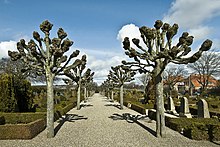

The urban cemetery is a burial ground located in the interior of a village, town, or city. Early urban cemeteries were churchyards, which filled apace and exhibited a haphazard placement of burial markers every bit sextons tried to clasp new burials into the remaining space. As new burial grounds were established in urban areas to recoup, burying plots were often laid out in a filigree to replace the chaotic appearance of the churchyard.[14] Urban cemeteries developed over time into a more landscaped grade as part of borough development of beliefs and institutions that sought to portray the city as civilized and harmonious.[15]
Urban cemeteries were more than germ-free (a place to safely dispose of decomposing corpses) than they were aesthetically pleasing. Corpses were usually cached wrapped in cloth, since coffins, burial vaults, and to a higher place-footing crypts inhibited the process of decomposition.[sixteen] However, urban cemeteries which were heavily used were often very unhealthy. Receiving vaults and crypts oft needed to be aired earlier entering, as decomposing corpses used up and so much oxygen that even candles could not remain lit.[17] The sheer stench from decomposing corpses, even when buried securely, was overpowering in areas side by side to the urban cemetery.[18] [19] Decomposition of the human being body releases significant pathogenic bacteria, fungi, protozoa, and viruses which can cause illness and illness, and many urban cemeteries were located without consideration for local groundwater. Modernistic burials in urban cemeteries too release toxic chemicals associated with embalming, such as arsenic, formaldehyde, and mercury. Coffins and burial equipment can also release significant amounts of toxic chemicals such as arsenic (used to preserve bury woods) and formaldehyde (used in varnishes and as a sealant) and toxic metals such equally copper, lead, and zinc (from coffin handles and flanges).[twenty]
Urban cemeteries relied heavily on the fact that the soft parts of the body would decompose in almost 25 years (although, in moist soil, decomposition tin have up to 70 years).[21] If room for new burials was needed, older bones could exist dug upwardly and interred elsewhere (such every bit in an ossuary) to make infinite for new interments.[16] Information technology was non uncommon in some places, such as England, for fresher corpses to exist chopped upwards to help decomposition, and for bones to be burned to create fertilizer.[22] The re-utilize of graves allowed for a steady stream of income, which enabled the cemetery to remain well-maintained and in good repair.[23] Not all urban cemeteries engaged in re-use of graves, and cultural taboos often prevented it. Many urban cemeteries have fallen into busted and get overgrown, as they lacked endowments to fund perpetual care. Many urban cemeteries today are thus dwelling house to wildlife, birds, and plants which cannot be plant anywhere else in the urban area, and many urban cemeteries in the tardily 20th century touted their function equally an environmental refuge.[24] [25]
Many urban cemeteries are characterized by multiple burials in the same grave. Multiple burials is a consequence of the express size of the urban cemetery, which cannot easily aggrandize due to adjacent building development. It was not uncommon for an urban cemetery to begin adding soil to the top of the cemetery to create new burial space.
Monumental [edit]
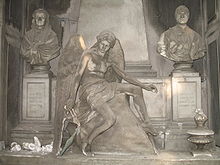
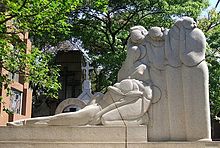
A awe-inspiring cemetery is the traditional fashion of cemetery where headstones or other monuments fabricated of marble, granite or similar materials ascension vertically above the ground (typically effectually l cm but some tin can be over 2 metres loftier). Frequently the unabridged grave is covered by a slab, commonly concrete, but information technology can exist more than expensive materials such equally marble or granite, and/or has its boundaries delimited by a contend which may be made of concrete, cast iron or timber. Where a number of family members are cached together (either vertically or horizontally), the slab or boundaries may encompass a number of graves.
Monumental cemeteries are often regarded equally unsightly due to the random collection of monuments and headstones they contain. Likewise, as maintenance of the headstones is the responsibility of family members (in the absence of a proscribed Perpetual Care and Maintenance Fund), over time many headstones are forgotten nigh and decay and become damaged. For cemetery authorities, monumental cemeteries are difficult to maintain. While cemeteries often have grassed areas between graves, the layout of graves makes information technology difficult to use modern equipment such as ride-on lawn mowers in the cemetery. Often the maintenance of grass must be done past more labour-intensive (and therefore expensive) methods. In club to reduce the labour cost, devices such as string trimmers are increasingly used in cemetery maintenance,[ citation needed ] but such devices can harm the monuments and headstones. Cemetery authorities dislike the criticism they receive for the deteriorating condition of the headstones, arguing that they accept no responsibility for the budget of headstones, and typically disregard their own maintenance practices as being i of the causes of that deterioration.[ commendation needed ]
Rural or garden [edit]

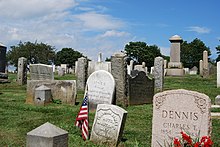

Old graveyard in Elazig, Turkey

A Muslim cemetery at sunset in Marrakech, Morocco
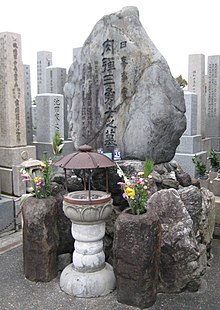
A cemetery in Kyoto, Nihon


The rural cemetery or garden cemetery[26] is a manner of burial basis that uses landscaping in a park-like setting. It was conceived in 1711 by the British architect Sir Christopher Wren, who advocated the creation of landscaped burial grounds which featured well-planned walkways which gave all-encompassing admission to graves and planned plantings of copse, bushes, and flowers.[27] Wren's idea was not immediately accepted. Only by the early 1800s, existing churchyards were growing overcrowded and unhealthy, with graves stacked upon each other or emptied and reused for new burials.[28] As a reaction to this, the first "garden" cemetery – Père Lachaise Cemetery in Paris – opened in 1804.[29] Because these cemeteries were usually on the outskirts of boondocks (where land was plentiful and cheap), they were called "rural cemeteries", a term still used to describe them today.[28] The concept quickly spread across Europe.[xxx]
Garden/rural cemeteries were non necessarily outside city limits. When land within a city could be constitute, the cemetery was enclosed with a wall to give it a garden-like quality. These cemeteries were often not sectarian, nor co-located with a house of worship. Inspired by the English landscape garden movement,[31] they oft looked similar attractive parks. The first garden/rural cemetery in the United States was Mount Auburn Cemetery well-nigh Boston, Massachusetts, founded by the Massachusetts Horticultural Society in 1831.[32] Post-obit the establishment of Mount Auburn, dozens of other "rural" cemeteries were established in the Usa – possibly in part because of Supreme Court Justice Joseph Story's dedication accost – and there were dozens of dedication addresses,[33] including the famous Gettysburg Address of President Abraham Lincoln.
The cost of building a garden/rural cemetery often meant that simply the wealthy could afford burial at that place.[34] Subsequently, garden/rural cemeteries often feature above-ground monuments and memorials, mausoleums, and columbaria. The excessive filling of rural/garden cemeteries with elaborate above-ground memorials, many of dubious artistic quality or taste, created a backfire which led to the development of the lawn cemetery.[35]
Lawn cemetery [edit]
In a review of British burying and death practises, Julie Rugg wrote that there were "4 closely interlinked factors that explain the 'invention' and widespread adoption of the lawn cemetery: the deterioration of the Victorian cemetery; a self-conscious rejection of Victorian aesthetics in favour of modern alternatives; resource difficulties that, especially afterwards World War II, increasingly constrained what might be accomplished in terms of cemetery maintenance; and growing professionalism in the field of cemetery management."[36]

Typically, lawn cemeteries contain a number of graves in a lawn setting with copse and gardens on the perimeter. Adolph Strauch introduced this manner in 1855 in Cincinnati.[37] While aesthetic appeal to family members has been the primary driver for the evolution of lawn cemeteries, cemetery government initially welcomed this new style of cemetery enthusiastically, expecting easier maintenance. Selecting (or grading) the land intended for a lawn cemetery then that it is completely flat allows the use of large efficient mowers (such as ride-on mowers or lawn tractors) - the plaques (existence horizontally set in the ground) lie below the level of the blades and are not damaged by the blades. Unfortunately, in practice, while families are often initially attracted to the uncluttered appearance of a lawn cemetery, the common practice of placing flowers (sometimes in vases) and increasingly other items (e.one thousand. small toys on children's graves) re-introduces some clutter to the cemetery and makes it difficult to use the larger mowers. While cemetery authorities increasingly impose restrictions on the nature and type of objects that can exist placed on lawn graves and actively remove prohibited items, grieving families are often unwilling to comply with these restrictions and get very upset if the items are removed. Another problem with lawn cemeteries involves grass over-growth over fourth dimension: the grass can grow over and encompass the plaque, to the distress of families who can no longer easily locate the grave. Grasses that propagate past an higher up-ground stolon (runner) tin can cover a plaque very quickly. Grasses that propagate by a below-basis rhizome tend not to encompass the plaque as easily.


Lawn beam [edit]
The backyard beam cemetery, a contempo development, seeks to solve the problems of the lawn cemetery while retaining many of its benefits. Depression (10–15 cm) raised concrete slabs (beams) are placed across the cemetery. Commemorative plaques (commonly standardised in terms of size and materials like to lawn cemeteries) stand on these beams adjacent to each grave. As in a lawn cemetery, grass grows over the graves themselves. The areas betwixt the beams are wide enough to permit easy mowing with a larger mower. As the mower blades are set lower than the top of the beam and the mowers exercise not go over the axle, the blades cannot damage the plaques. Upwards on the axle, the plaques cannot be easily overgrown by grass, and spaces between the plaques permit families to place flowers and other objects out of attain of the mowing.
Natural [edit]
A natural cemetery, eco-cemetery, green cemetery or conservation cemetery, is a new style of cemetery as an area set aside for natural burials (with or without coffins). Natural burials are motivated by a want to be environmentally witting with the body rapidly decomposing and condign role of the natural environment without incurring the environmental cost of traditional burials. Certifications may exist granted for various levels of greenish burial. Dark-green burying certifications are issued in a tiered system reflecting level of natural burying practise. Green burying certification standards designate a cemetery as Hybrid, Natural, or Conservation Burial Grounds.
Many scientists have argued that natural burials would exist a highly efficient use of land if designed specifically to salvage endangered habitats, ecosystems and species.[38]
The opposite has as well been proposed. Instead of letting natural burials permanently protect wild landscapes, others accept argued that the rapid decomposition of a natural burying, in principle, allows for the quick re-use of grave sites in comparison with conventional burials. However, it is unclear if reusing cemetery state will be culturally adequate to most people.
In keeping with the intention of "returning to nature" and the early re-use potential, natural cemeteries do not normally take conventional grave markings such equally headstones. Instead, verbal GPS recordings and or the placing of a tree, bush-league or rock often marks the location of the dead, and then grieving family and friends tin visit the precise location of a grave.
Columbarium wall [edit]

Columbarium walls are a common characteristic of many cemeteries, reflecting the increasing apply of cremation rather than burial. While cremated remains can be kept at home by families in urns or scattered in some significant or attractive place, neither of these approaches allows for a long-lasting commemorative plaque to laurels the expressionless nor provide a identify for the wider circle of friends and family to come to mourn or visit. Therefore, many cemeteries now provide walls (typically of brick or rendered brick construction) with a rectangular array of niches, with each niche being large enough to adjust a person's cremated remains. Columbarium walls are a very infinite-efficient use of land in a cemetery compared with burials and a niche in a columbarium wall is a much cheaper alternative to a burying plot. A small plaque (most xv cm x 10 cm) can be affixed across the front of each niche and is generally included as function of the price of a niche. As the writing on the plaques has to be fairly small to fit on the small size of the plaque, the pattern of columbarium walls is constrained by the ability of visitors to read the plaques. Thus, the niches are typically placed between 1 metre to 2 metres above the footing so the plaques can be easily read by an developed. Some columbarium walls have niches going close to basis level, but these niches are commonly unpopular with families as it is difficult to read the plaque without angle down very low (something older people in particular discover hard or uncomfortable to do).
Equally with graves, the niches may be assigned by the cemetery authorities or families may choose from the unoccupied niches available. It is usually possible to purchase (or pay a deposit) to reserve the utilize of adjacent niches for other family members. The use of adjacent niches (vertically or horizontally) unremarkably permits a larger plaque spanning all the niches involved, which provides more than space for the writing. Every bit with graves, in that location may be separate columbarium walls for unlike religions or for war veterans. Equally with lawn cemeteries, the original expectation was that people would prefer the uncluttered simplicity of a wall of plaques, but the exercise of leaving flowers is very entrenched. Mourners exit flowers (and other objects) on summit of columbarium walls or at the base, as close every bit they can to the plaque of their family member. In some cases, it is possible to squeeze a piece of wire or string under the plaque allowing a blossom or modest posy to exist placed on the plaque itself or clips are glued onto the plaque for that purpose. Newer designs of columbarium walls accept this desire to go out flowers into business relationship by incorporating a metal clip or loop abreast each plaque, typically designed to hold a single bloom stem or a small posy. As the flowers decay, they just fall to the ground and do not create a significant maintenance problem.
Family unit [edit]

Holland Cemetery: A rural cemetery in northeast Oklahoma

Family unit cemeteries in India

While uncommon today, family (or individual) cemeteries were a matter of practicality during the settlement of America. If a municipal or religious cemetery had not been established, settlers would seek out a small plot of land, often in wooded areas bordering their fields, to begin a family unit plot. Sometimes, several families would arrange to bury their dead together. While some of these sites later grew into true cemeteries, many were forgotten later a family unit moved abroad or died out.
Today, information technology is not unheard of to discover groupings of tombstones, ranging from a few to a dozen or more, on undeveloped land. Every bit tardily 20th-century suburban sprawl pressured the pace of development in formerly rural areas, it became increasingly common for larger exurban properties to be burdened by "religious easements", which are legal requirements for the belongings owner to permit periodic maintenance of minor burial plots located on the holding but technically not owned with information technology. Often, cemeteries are relocated to arrange building. Withal, if the cemetery is not relocated, descendants of people buried there may visit the cemetery.[39]
There is also the practice of families with large estates choosing to create private cemeteries in the form of burial sites, monuments, crypts, or mausoleums on their property; the mausoleum at Fallingwater is an case of this practice. Burial of a body at a site may protect the location from redevelopment, with such estates often being placed in the care of a trust or foundation. In the United States, country regulations take made it increasingly hard, if non impossible, to get-go individual cemeteries; many crave a programme to care for the site in perpetuity. Private cemeteries are nearly e'er forbidden on incorporated residential zones. Many people will coffin a dear pet on the family belongings.
Arabian tribal [edit]
All of the Saudis in Al Baha are Muslims, and this is reflected in their cemetery and funeral customs. "The southern tribal hinterland of Baha – dwelling to especially the Al-Ghamdi and Al-Zahrani tribes – has been renowned for centuries for their tribal cemeteries that are now slowly vanishing", co-ordinate to the Asharq Al-Awsat newspaper: "One old villager explained how tribal cemeteries came near. 'People used to dice in large numbers and very rapidly one after the other because of diseases. So the villagers would dig graves close by burying members of the same family in ane area. That was how the family and tribal burial grounds came about... If the family ran out of infinite, they would open old graves where family members had been buried before and add more people to them.
This process is known as khashf. During famines and outbreaks of epidemics huge numbers of people would die and many tribes faced difficulties in earthworks new graves because of the difficult weather. In the past, some Arab winters lasted for more than six months and would be accompanied with much rain and fog, impeding motility. But due to tribal rivalries many families would baby-sit their cemeteries and put restrictions on who was buried in them. Across Baha, burying grounds have been constructed in different ways. Some cemeteries consist of undercover vaults or concrete burial chambers with the capacity of holding many bodies simultaneously. Such vaults include windows for people to peer through and are usually decorated ornately with text, drawings, and patterns. At to the lowest degree 1 resident believes that the graves unique in the region because many are not oriented toward Mecca, and therefore must pre-date Islam.[twoscore]
Terraced [edit]
Graves are terraced in Yagoto Cemetery, which is an urban cemetery situated in a hilly area in Nagoya, Japan, effectively creating rock walls blanketing hillsides.[41]
Miscellaneous [edit]
The Cross Bones is a burial ground for prostitutes in London. The Neptune Memorial Reef is an underwater columbarium near Central Biscayne.[42]
Online memorials [edit]
In the 2000s and 2010s, it has become increasingly mutual for cemeteries and funeral homes to offer online services. There are also stand up-alone online "cemeteries" such equally Find a Grave, Canadian Headstones, Interment.net, and the Globe Wide Cemetery.[43] [44]
Community and practices [edit]
Flowers [edit]

In Western countries, and many others,[ quantify ] visitors to graves ordinarily get out cut flowers, especially during major holidays and on birthdays or relevant anniversaries. Cemeteries usually dispose of these flowers after a few weeks in order to keep the space maintained. Some companies offer perpetual flower services, to ensure a grave is always busy with fresh flowers.[45] Flowers may often be planted on the grave as well, usually immediately in front of the gravestone. For this purpose roses are highly common.
In some regions flowers are put out at specific times called Decoration Days.
Stones [edit]

Small stones on a gravestone in a Jewish cemetery in Germany
Visitors to loved ones interred in Jewish cemeteries often leave a small stone on the top of the headstone. There are prayers said at the gravesite, and the stone is left on the visitor's difference. It is done equally a evidence of respect; as a general rule, flowers are not placed at Jewish graves. Flowers are fleeting; the symbology inherent in the use of a stone is to show that the dear, honor, memories, and soul of the loved ane are eternal. This practice is seen in the endmost scene of the film Schindler's List, although in that example information technology is not on a Jewish grave.
Crosses [edit]

Wooden crosses with remembrance poppies on them
War graves will commonly have minor timber remembrance crosses left with a red poppy attached to its heart. These will often have messages written on the cross. More than formal visits will oft go out a poppy wreath. Jewish state of war graves are sometimes marked past a timber Star of David.
Candles [edit]
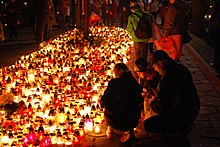
Placing burning grave candles on the cemetery to commemorate the expressionless is a very common tradition in Cosmic nations, for example, Poland. Information technology is mostly practised on All Souls' Day. The traditional grave candles are chosen znicz in Shine.[46] A like practice of grave candles is also used in Eastern Orthodox Christian nations, as well equally the Lutheran Christian Nordic countries.
Toys [edit]
In the American South, graves of children are often decorated with emblems of childhood. These include favorite toys, balloons, seasonal decorations, religious figurines, and more.[47]
Contemporary management [edit]
Traditionally cemetery management but involves the allocation of land for burial, the digging and filling of graves, and the maintenance of the grounds and landscaping. The construction and maintenance of headstones and other grave monuments are usually the responsibilities of surviving families and friends. However, increasingly, many people regard the resultant collection of individual headstones, concrete slabs and fences (some of which may exist decayed or damaged) to be aesthetically unappealing, leading to new cemetery developments either standardising the shape or design of headstones or plaques, sometimes by providing a standard shaped marking as part of the service provided by the cemetery.
Grave excavation [edit]
Cemetery authorities unremarkably use a total-time staff of caretakers to dig graves. The term "gravedigger" is still used in coincidental speech, though many cemeteries take adopted the term "caretaker", since their duties ofttimes involve maintenance of the cemetery grounds and facilities. The employment of skilled personnel for the preparation of graves is done not only to ensure the grave is dug in the correct location and at the correct depth, merely as well to salve families from having to dig the grave for a recently dead relative, and equally a matter of public safety, in club to forbid inexperienced visitors from injuring themselves, to ensure unused graves are properly covered, and to avoid legal liability that would event from an injury related to an improperly dug or uncovered grave. Grooming of the grave is ordinarily done before the mourners get in for the burying. The cemetery caretakers fill the grave after the burial, generally afterward the mourners have departed. Mechanical equipment, such every bit backhoes, are used to reduce labour price of excavation and filling, just some mitt shovelling may notwithstanding be required.
In the United Kingdom the minimum depth from the surface to the highest lid is 36 inches (91.4 cm). At that place must exist 6 inches (fifteen.2 cm) between each bury, which on average is xv inches (38.1 cm) high. If the soil is gratis-draining and porous, only 24 inches (61 cm) of soil on top is required. Coffins may be interred at bottom depths or even above ground as long equally they are encased in a concrete chamber.[48] Earlier 1977, double graves were dug to 8 feet (243.8 cm) and singles to 6 feet (182.nine cm). As a single grave is now dug to 54 inches (137.ii cm), old cemeteries incorporate many areas where new single graves can be dug on "old ground". This is considered a valid method of resource management and provides income to keep older cemeteries viable, thus forestalling the demand for permanent closure, which would effect in a reduction of their work force.
Cemetery cardinal [edit]

Cemetery key of a pastor with a manus-in-hand era around 1935
The key is a zental element of Christianity.[49] Keys of decease and hell as a metaphor and synonym for these often stands the cemetery key. - "Christ says: I was expressionless, and behold, I am alive from eternity to eternity, and have the keys of death and hell." (Revelation one:18). Peter is given privilege to allow different groups to enter the Kingdom of Heaven. He gets three keys that he uses. (Acts ii:37, 38; viii:xiv-17; 10:44-48) Today it is likewise integrated in many games every bit the "graveyard key holder".[50]
Burying registers [edit]
Usually there is a legal requirement to maintain records regarding the burials (or interment of ashes) within a cemetery. These burial registers normally contain (at a minimum) the name of the person cached, the appointment of burial and the location of the burial plots within the cemetery, although some contain far more than detail. The Arlington National Cemetery, ane of the United States' largest war machine cemeteries, has a registry, The ANC Explorer, which contains details such as photographs of the front and dorsum of the tombstones.[51] Burial registers are an important resource for genealogy.
Land use [edit]
In order to physically manage the space within the cemetery (to avert burials in existing graves) and to tape locations in the burial register, most cemeteries have some systematic layout of graves in rows, by and large grouped into larger sections as required. Often the cemetery displays this information in the form of a map, which is used both by the cemetery administration in managing their country utilise and also by friends and family members seeking to locate a detail grave within the cemetery.
Pressures [edit]
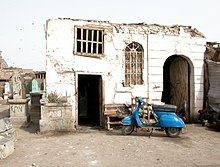
A tomb retrofitted as a residence in the City of the Dead. Cairo's City of the Expressionless is a centuries-erstwhile cemetery that has become home to equally many as one meg Egyptians during the last decades.[52]
Cemetery regime confront a number of tensions in regard to the direction of cemeteries.
I effect relates to price. Traditionally a single payment is made at the time of burying, but the cemetery authority incurs expenses in cemetery maintenance over many decades. Many cemetery authorities discover that their accumulated funds are not sufficient for the costs of long-term maintenance. This shortfall in funds for maintenance results in three main options: charge much higher prices for new burials, obtain some other kind of public subsidy, or neglect maintenance. For cemeteries without space for new burials, the options are even more than limited. Public attitudes towards subsidies are highly variable. People with family unit buried in local cemeteries are ordinarily quite concerned about neglect of cemetery maintenance and will usually argue in favour of public subsidy of local cemetery maintenance, whereas other people without personal connexion to the cemetery often fence that public subsidies of private cemeteries is an inappropriate apply of their taxes. Some jurisdictions crave a certain corporeality of money be ready aside in perpetuity and invested so that the interest earned tin can be used for maintenance.[53]
Some other effect relates to express amount of land. In many larger towns and cities, the older cemeteries which were initially considered to be large often run out of space for new burials and at that place is no vacant adjacent land bachelor to extend the cemetery or even land in the same full general area to create new cemeteries. New cemeteries are generally established on the periphery of towns and cities, where big tracts of land are still available. Nevertheless, people often wish to be buried in the same cemetery as other relatives, and are not interested in beingness buried in new cemeteries with which there is no sense of connectedness to their family, creating pressure to find more space in existing cemeteries.
A third issue is the maintenance of monuments and headstones, which are more often than not the responsibility of families, but frequently become neglected over time. Decay and impairment through vandalism or cemetery maintenance practices can return monuments and headstones either dangerous or at least unsightly. On the other hand, some families do non forget the grave but constantly visit, leaving backside flowers, plants, and other decorative items that create their ain maintenance problem.
Re-utilise of graves [edit]

Prague'due south Old Jewish Cemetery is the last resting place for more 100,000 people who had been buried here since the 15th century.

All of these bug tend to put pressure level on the re-utilise of grave sites within cemeteries. The re-use of graves already used for burial tin cause considerable upset to family members. Although the authorities might declare that the grave is sufficiently former that there will be no human remains notwithstanding nowadays, nonetheless many people regard the re-use of graves (especially their family unit's graves) as a desecration. Also re-utilise of a used grave involves the removal of whatsoever monuments and headstones, which may cause farther distress to families (although families will typically be allowed to take away the monuments and headstones if they wish).
On the other paw, cemetery government are well aware that many old graves are forgotten and not visited and that their re-apply volition not crusade distress to anyone. Nonetheless, there may be some older graves in a cemetery for whom in that location are local and song descendants who volition mount a public campaign against re-use. One pragmatic strategy is to publicly announce plans to re-utilise older graves and invite families to respond if they are willing or not. Re-apply then simply occurs where in that location are no objections allowing the "forgotten" graves to be re-used. Sometimes the cemetery authorities asking a farther payment to avoid re-employ of a grave, simply often this backfires politically.
A practical trouble with regard to contacting families is that the person who initially purchased the burial plot(s) may have subsequently died and locating living family unit members, if whatsoever, many decades afterward is about impossible (or at least prohibitively expensive). Public observe near the proposed re-utilise of graves may or may non reach family members living further afield who may object to such practices. Therefore, it is possible that re-utilise could occur without family awareness.
Some cemeteries did foresee the demand for re-use and included in their original terms and conditions a limited tenure on a grave site and nearly new cemeteries follow this practice, having seen the problems faced past older cemeteries. Common exercise in Europe is to identify bones in an ossuary later on the proscribed burial period is over.[53]
Notwithstanding, fifty-fifty when the cemetery has the legal right to re-use a grave, strong public stance often forces the authorities to back downwardly on that re-utilize. Also, even when cemeteries take a limited tenure provision in place, funding shortages can force them to contemplate re-use earlier than the original arrangements provided for.
Another blazon of grave site considered for re-use are empty plots purchased years agone but never used. In principle it would seem easier to "re-utilise" such grave sites equally there can be no claims of desecration, simply often this is made complicated by the legal rights to be buried obtained past the pre-buy, as any express tenure clause simply takes consequence after in that location has been a burial. Over again, cemetery authorities suspect that in many cases the holders of these burial rights are probably dead and that nobody will exercise that burial right, but again some families are aware of the burying rights they possess and do intend to practice them as and when family members die. Over again the difficulty of being unable to locate the holders of these burial rights complicates the re-use of those graves.
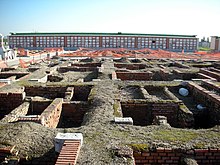
Cemetery excavations, similar this one in Madrid, tin can alleviate overcrowding.
Equally historic cemeteries begin to attain their capacity for full burials, alternative memorialization, such as commonage memorials for cremated individuals, is becoming more common. Different cultures have unlike attitudes to destruction of cemeteries and use of the land for structure. In some countries information technology is considered normal to destroy the graves, while in others the graves are traditionally respected for a century or more. In many cases, after a suitable period of time has elapsed, the headstones are removed and the now former cemetery is converted to a recreational park or structure site. A more recent trend, particularly in South American cities, involves constructing loftier-ascent buildings to house graves.[54]
Cemeteries in the U.s. may exist relocated if the country is required for other reasons. For instance, many cemeteries in the southeastern United States were relocated by the Tennessee Valley Authority from areas well-nigh to be flooded past dam construction.[55] Cemeteries may also exist moved then that the state can be reused for transportation structures,[56] [57] public buildings,[58] or even private development.[59] Cemetery relocation is non necessarily possible in other parts of the earth; in Alberta, Canada, for instance, the Cemetery Human action expressly forbids the relocation of cemeteries or the mass exhumation of marked graves for any reason whatsoever.[threescore] This has caused pregnant problems in the provision of transportation services to the southern one-half of the Urban center of Calgary, every bit the main southbound route connecting the south end of the metropolis with downtown threads through a serial of cemeteries founded in the 1930s. The light rail transit line running to the south end eventually had to be built directly under the road.

A belltower at Forest Domicile Cemetery, in Fifield, Wisconsin. Tolling bells during funerals has been customary in some places around the world.
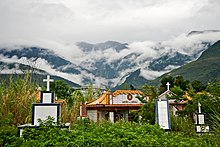
Superstitions [edit]

In many countries, cemeteries are places believed to hold both superstition and legend characteristics, being used, usually at night times, every bit an altar in supposed black magic ceremonies or similarly clandestine happenings, such as devil worshipping, grave-robbing (golden teeth and jewelry are preferred), thrilling sexual practice encounters, or drug and alcohol abuse non related to the cemetery aureola.
The legend of zombies, as romanticized by Wade Davis in The Serpent and the Rainbow, is not exceptional among cemetery myths, as cemeteries are believed to be places where witches and sorcerers get skulls and bones needed for their sinister rituals.
In the Afro-Brazilian urban mythos (such every bit Umbanda), there is a character loosely related to cemeteries and its aura: the Zé Pilintra (in fact, Zé Pilintra is more than related to bohemianism and night life than with cemeteries, where the reigning entity is Exu Caveira or Exu Cemitério, similar to Voodoo Baron Samedi).
Meet also [edit]
- Corpse route
- Pet cemetery
- Prison house cemetery
- Lists of cemeteries by state
- Crypt
- Churchyard
- Coemeterium
- Columbarium
- Crypt
- Grave field
- Mass grave
- Necropolis
- Ossuary
- Tomb
- Tumulus
- Unmarked grave
- War grave
References [edit]
- ^ κοιμητήριον . Liddell, Henry George; Scott, Robert; A Greek–English Lexicon at the Perseus Project
- ^ Harper, Douglas. "cemetery". Online Etymology Lexicon.
- ^ "cemetery". Oxford English Dictionary (Online ed.). Oxford University Press. (Subscription or participating establishment membership required.)
- ^ Upendran, S. (October 25, 2011). "Know Your English: Difference between 'graveyard' and 'cemetery'". The Hindu.
- ^ "What's the Difference Between a Graveyard and a Cemetery". January 19, 2013.
- ^ a b Klevnäs, Alison; Aspöck, Edeltraud; Noterman, Astrid A.; van Haperen, Martine C.; Zintl, Stephanie (August 2021). "Reopening graves in the early Middle Ages: from local practice to European phenomenon". Antiquity: A Review of Earth Archaeology. Cambridge: Cambridge University Press. 95 (382): 1005–1026. doi:10.15184/aqy.2020.217. eISSN 1745-1744. ISSN 0003-598X.
- ^ "Paris' Clandestine Underworld". CBS News. September 27, 2004
- ^ Meller, Hugh (1981). London Cemeteries: An Illustrated Guide and Gazetteer. Amersham: Avebury. ISBN978-0861270033.
- ^ Melanie Louise Simo (1988) Loudon and the Landscape, p. 283.
- ^ "Friends of Beckett Street Cemetery". beckettstreetcemetery.org.uk.
- ^ Rebecca Greenfield (March 16, 2011). "Our First Public Parks: The Forgotten History of Cemeteries". The Atlantic.
- ^ Blanche Linden-Ward (1989). "12 Foreign but Genteel Pleasure Grounds: Tourist and Leisure Uses of Nineteenth-Century Rural Cemeteries". Cemeteries & Gravemarkers. Academy Press of Colorado, Utah State Academy Printing. pp. 293–328. doi:x.2307/j.ctt46nqxw.nineteen. ISBN9780874211603. JSTOR j.ctt46nqxw.xix.
- ^ Lomax, John Nova. "The Seoul of Houston: The Weather Was Not the Strong Betoken on Long Point Archived 2008-08-29 at the Wayback Machine." Houston Press. January 30, 2008.
- ^ Mytum 2004, p. 50.
- ^ Worpole 2003, pp. 11–12.
- ^ a b Nonini 2014, p. 390.
- ^ Flanders 2014, p. 220.
- ^ Carroll 2013, p. 362.
- ^ Upton 1997, p. 131–132.
- ^ Taylor & Allen 2006, pp. 342–342.
- ^ Meuser 2010, p. 137.
- ^ Flanders 2014, pp. 219–221.
- ^ Worpole 2003, p. 8.
- ^ Worpole 2003, p. 173.
- ^ Forman 2014, pp. 357–358.
- ^ Keels 2003, p. 21.
- ^ van Rensslaer, M. G. (June 3, 1891). "Garden and Forest". Sir Christopher Wren equally Gardener: 254–255.
- ^ a b LeeDecker 2009, pp. 145, 148.
- ^ Thomas 2003, p. 32.
- ^ Mickey 2013, p. 17.
- ^ Vercelloni & Vercelloni 2010, p. 198.
- ^ Hodgson 2001, p. 30.
- ^ Brophy, Alfred (2016). "The Route to the Gettysburg Accost" (PDF). Florida Land University Law Review. 43: 831–905.
- ^ Harney 2014, p. 102.
- ^ Mytum 2004, p. 51.
- ^ Rugg, Julie (2006). "Lawn cemeteries: the emergence of a new landscape of death". Urban History. 33 (2): 213–233. doi:10.1017/S0963926806003786. ISSN 0963-9268. S2CID 145306627.
- ^ Sears, John F. (1989). Sacred Places: American Tourist Attractions in the Nineteenth Century. University of Massachusetts Press. pp. 117–118. ISBN978-1558491625 . Retrieved July 25, 2013.
Beginning introduced in 1855 by Adolph Strauch, superintendent of the Leap Grove Cemetery in Cincinnati, the park or lawn cemetery featured open, uncluttered expanses of backyard rather than the uneven, wooded, picturesque scenery of the rural cemetery. [...] By the final decades of the nineteenth century, the park cemetery would become the ascendant grade of American burial basis.
- ^ Holden, Matthew H.; McDonald-Madden, Eve (2018). "Conservation from the Grave: Human Burials to Fund the Conservation of Threatened Species". Conservation Letters. 11: e12421. doi:10.1111/conl.12421. ISSN 1755-263X.
- ^ Brophy, Alfred (2006). "Grave Matters: The Aboriginal Rights of the Graveyard". BYU Law Review. 2006 (6). Article 2. The "ancient right" of the graveyard is that descendants of those buried on private belongings have – in many states – an unsaid easement "in gross" to visit that cemetery. The boundaries of this right, in terms of how frequently descendants (and in a few states other interested people) may visit and for how long, vary by state. In a few southern states, this is provided by legislation; in more states, information technology is protected by common constabulary decisions. In some states, the right is not nevertheless established by either statute or cases, although it seems likely that in an advisable challenge most, maybe all, states will recognize at least limited rights of admission. Meet Brophy, supra.
- ^ "Tradition of Family Cemeteries Disappearing From Tribal Areas". Arab News. September 9, 2006.
- ^ "名古屋市の霊園 a behemothic terraced cemetery in Nagoya – 元東京人の名古屋まち歩き".
- ^ "Nearly the Reef". Neptune Memorial Reef.
- ^ Lives Lived: Michael Stanley Kibbee, M.Sc., P.Eng. The Globe and Mail, March 20, 1997.
- ^ "Internet WayBack Motorcar (World Wide Cemetery)". Retrieved March xiv, 2017.
- ^ ""City cemetery draws visitors for 150 years"".
- ^ "Zaduszkowe tradycje". TVP Białystok (in Polish). November two, 2012.
- ^ Jeane, D. Gregory (2009). "Cemeteries". In Hinson, Glenn; Ferris, William (eds.). The New Encyclopedia of Southern Culture: Volume 14: Folklife. UNC Printing. p. 61.
- ^ Local Authorities Cemeteries Guild 1977
- ^ "Streit um einen Friedhofsschlüssel". world wide web.gnz.de.
- ^ "Last Fantasy 7 Remake | Alle Aufträge und Nebenstorys". spieletipps.de. Oct four, 2020.
- ^ "Arlington National Cemetery Records Go Online". OnlineSearches News 11.01.2012
- ^ "Tomb with a view". BBC News. March 6, 2002
- ^ a b "Can Your Cemetery Really Bury You Forever? | Planet Coin | NPR". April 18, 2018. Archived from the original on October xxx, 2021 – via YouTube.
- ^ News: New tendency: Cemetery Skyscrapers Archived November 11, 2006, at the Wayback Machine
- ^ Cemeteries Relocated past TVA. Accessed July 13, 2009.
- ^ "O'Hare Growth May Mean Moving a Cemetery". NPR, November xix, 2005. Accessed July 13, 2009.
- ^ St. Johannes Cemetery Relocation. Accessed July xiii, 2009.
- ^ "Remains in 19th century graves downtown ID'd as soldiers". The Tucson Denizen, April 17, 2009. Accessed July 13, 2009.
- ^ "Cemetery Relocation Battle Ongoing". Archived May 9, 2008, at the Wayback Machine Platte County Citizen, July four, 2007. Accessed July 13, 2009.
- ^ "Cemeteries registration". www.alberta.ca.
Bibliography [edit]
- Cantor, Norman Fifty. (2010). Later We Die: The Life and Times of the Homo Cadaver. Washington, D.C.: Georgetown University Press. ISBN978-1589017139.
- Carmack, Sharon DeBartolo (2002). Your Guide to Cemetery Inquiry . Betterway Books. ISBN978-1558705890.
- Carroll, Andrew (2013). Hither Is Where: Discovering America's Great Forgotten History. New York: Crown Archetype. ISBN978-0307463999.
- Colvin, Howard (1991). Architecture and the After-Life. New Haven: Yale Academy Press.
- Whorl, James Stevens (2002). Decease and Architecture. Gloucestershire: Sutton.
- Eggener, Keith (2010). Cemeteries. New York: W.W. Norton & Co. ISBN978-0393731699.
- Etlin, Richard A. (1984). The Architecture of Expiry: the transformation of the cemetery in eighteenth-century Paris. Cambridge, MA: MIT Press.
- Flanders, Judith (2014). The Victorian Metropolis: Everyday Life in Dickens' London. New York: Thomas Dunne Books. ISBN978-1250040213.
- Forman, Richard T.T. (2014). Urban Ecology: Scientific discipline of Cities. Cambridge, U.K.: Cambridge University Press. ISBN978-1107007000.
- Grossman, Janet Burnett (2001). Greek Funerary Sculpture. Catalogue of the Collection at the Getty Villa. Los Angeles: J. Paul Getty Museum.
- Harney, Marion (2014). Gardens and Landscapes in Historic Building Conservation. Chichester, W Sussex, U.K.: John Wiley & Sons. ISBN978-1118508121.
- Hodgson, Larry (2001). The Garden Lover's Guide to Canada. New York: Princeton Architectural Printing. ISBN978-1568982793.
- Keels, Thomas H. (2003). Philadelphia Graveyards and Cemeteries. Charleston, Southward.C.: Arcadia. ISBN978-0738512297.
- LeeDecker, Charles H. (2009). "Preparing for an Afterlife of Earth: The Transformation of Mortuary Beliefs in Nineteenth-Century North America". In Majewski, Teresita; Gaimster, David R. Chiliad. (eds.). International Handbook of Historical Archæology. New York: Springer. ISBN978-0387720685.
- Meuser, Helmut (2010). Contaminated Urban Soils. Dordrecht, Netherlands: Springer. ISBN978-9048193271.
- Mickey, Thomas J. (2013). America'due south Romance With the English Garden. Athens, Ohio: Ohio Academy Printing. ISBN978-0821420355.
- Mytum, Harold (2004). Mortuary Monuments and Burial Grounds of the Historic Period. New York: Kluwer Bookish Publishing. ISBN978-0306480751.
- Nonini, Donald Macon (2014). A Companion to Urban Anthropology. Malden, Mass.: Wiley-Blackwell. ISBN978-1118378649.
- Salisbury, Mike. "From My Death May Life Come up Forth. A Feasibility Study of the Woodland Cemetery in Canada". Earthartist.com.
- Taylor, Richard; Allen, Alistair (2006). "Waste Disposal and Landfill: Potential Hazards and Data Needs". In Schmoll, Oliver; Howard, Guy; Chilton, John; Chorus, Ingrid (eds.). Protecting Groundwater for Health: Managing the Quality of Drinking-Water Sources. Cornwall, U.K.: World Wellness Organisation. ISBN978-1843390794.
- Thomas, Jeannie B. (2003). Naked Barbies, Warrior Joes, and Other Forms of Visible Gender . Urbana, Sick.: University of Illinois Press. p. 32. ISBN978-0252028540.
- Upton, Dell (1997). "The Urban Cemetery and the Urban Community: The Origin of the New Orleans Cemetery". In adams, Annmarie; McMurry, Emerge Ann (eds.). Exploring Everyday Landscapes. Knoxville, Tenn.: Academy of Tennessee Printing. ISBN978-0870499838.
- Vercelloni, Matteo; Vercelloni, Virgilio (2010). Inventing the Garden. Los Angeles: J. Paul Getty Museum. ISBN978-1606060476.
- Worpole, Ken (2003). Terminal Landscapes: the architecture of the cemetery in the Due west. London: Reaktion Books. ISBN978-1861891617.
External links [edit]
| | Look up cemetery in Wiktionary, the free lexicon. |
| | Wikimedia Commons has media related to Cemeteries. |
| | Wikiquote has quotations related to: Cemetery |
- Cemeteries at Curlie
Source: https://en.wikipedia.org/wiki/Cemetery
0 Response to "Do You Have to Have a Family Member Burried in Cemetery to Be a Cemetery Board Member"
Postar um comentário